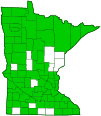rough cocklebur
(Xanthium strumarium)
Conservation • Wetland • Description • Habitat • Ecology • Use • Distribution • Taxonomy
Description |
||
Rough cocklebur is an annual forb that rises from a stout, somewhat woody taproot. It can be from 8″ to 32″ tall at maturity, but in Minnesota is usually no more than 18″ in height. The stems are erect or ascending and unbranched or sparsely branched. They are almost hairless or are rough to the touch and sparsely to moderately covered with short, ascending, appressed hairs. They are often covered with resinous dots (glands). They do not have spines at the nodes. The lower leaves are alternate. The upper 2 to 6 leaves are usually alternate, sometimes opposite. They are on ¾″ to 5″ long leaf stalks (petioles). The petioles are about as long as the leaf blades. The blades are broadly egg-shaped to kidney-shaped or nearly circular, ¾″ to 7″ long, and ¾″ to 6″ wide. They are usually heart-shaped at the base and are sometimes palmately divided into 3 or 5 broad, shallow lobes. The upper and lower surfaces are rough to the touch due to short, stiff hairs. The underside is not whitened. The margins are coarsely and irregularly toothed. Male and female flowers are borne on the same plant in spikes rising from the leaf axils and at the end of the stem. The lower spikes often have all female (pistillate) flower heads, the upper ones often all male (staminate) flower heads. Most spikes have a cluster of several staminate heads at the top and sometimes 1, usually 2 to 4, pistillate heads at the base. The spikes are 1″ to 4″ long, shorter than the stalk of the subtending leaf. The male flower heads are about ¼″ in diameter. They have 20 to 60 disk florets and no ray florets. The female flower head is oblong ellipse-shaped, with all but the outermost bracts of the involucre fused into a bur. The burs are yellow-green, yellowish-brown, or brown, ⅝″ to 1 3 ⁄16″ long, and completely enclose the 2 female florets in separate chambers. They have 2 narrow, prolonged tips (beaks) that are hooked or curled at the top. They are covered with numerous, sharp spines that are hooked or curled at the tip. At the base of the spines there may be fine, short hairs and/or stalked or unstalked glands. The fruit is two single-seeded capsules (achenes), one in each chamber of the bur. One seed germinates the first year, the other germinates the following year. |
||
Height |
||
8″ to 32″ |
||
Flower Color |
||
Green |
||
Similar Species |
||
|
||
Habitat |
||
Moist to moderate moisture. Croplands, abandoned fields, beaches, sand dunes, disturbed sites. Full or partial sun. |
||
Ecology |
||
Flowering |
||
August to September |
||
Pests and Diseases |
||
|
||
Use |
||
|
||
Distribution |
||||
|
Sources |
|||
| 6/6/2023 | ||||
Nativity |
||||
Native |
||||
Occurrence |
||||
|
||||
Taxonomy |
|||
| Kingdom | Plantae (Plants) | ||
| Division | Tracheophyta (Vascular Plants) | ||
| Subdivision | Spermatophytina (Seed Plants) | ||
| Class | Magnoliopsida (Dicots) | ||
Order |
Asterales (Sunflowers, Bellflowers, Fanflowers, and Allies) | ||
Family |
Asteraceae (Sunflowers, Daisies, Asters, and Allies) | ||
| Subfamily | Asteroideae | ||
| Supertribe | Helianthodae | ||
| Tribe | Heliantheae (Sunflowers and Allies) | ||
| Subtribe | Ambrosiinae (cockleburs, ragweeds, and wild quinines) | ||
| Genus | Xanthium (cockleburs) | ||
Subordinate Taxa |
|||
Twelve or more subspecies, varieties, or forms of Xanthium strumarium have been described, mostly based on subtle differences in the the burs. USDA PLANTS recognizes three varieties of Xanthium strumarium, two of which occur in Minnesota. GBIF recognizes one subspecies and two varieties, with only the nominate subspecies, Xanthium strumarium ssp.strumarium, occurring in North America. World Flora Online recognizes one subspecies that occurs in Mediterranean, Russia, and the Caucasus, but its status is questionable. ITIS, GRIN, Plants of the World Online, The Global Compositae Database, and The Global Compositae Checklist recognize no varieties. |
|||
Synonyms |
|||
Xanthium acerosum Xanthium americanum Xanthium californicum Xanthium californicum var. rotundifolium Xanthium calvum Xanthium campestre Xanthium canadense Xanthium cavanillesii Xanthium cenchroides Xanthium chasei Xanthium chinense Xanthium commune Xanthium curvescens Xanthium cylindraceum Xanthium echinatum Xanthium echinellum Xanthium glanduliferum Xanthium globosum Xanthium inflexum Xanthium italicum Xanthium macounii Xanthium macrocarpum var. glabratum Xanthium occidentale Xanthium oligacanthum Xanthium orientale Xanthium oviforme Xanthium pensylvanicum Xanthium saccharatum Xanthium speciosum Xanthium strumarium var. canadense Xanthium strumarium var. glabratum Xanthium strumarium ssp. italicum Xanthium strumarium var. oviforme Xanthium strumarium var. pensylvanicum Xanthium strumarium var. strumarium Xanthium strumarium var. wootonii Xanthium varians Xanthium wootonii |
|||
Common Names |
|||
cocklebur cockleburr common cocklebur rough cocklebur rough cockleburr |
|||
Glossary
Achene
A dry, one-chambered, single-seeded seed capsule, formed from a single carpel, with the seed attached to the membranous outer layer (wall) only by the seed stalk; the wall, formed entirely from the wall of the superior ovary, does not split open at maturity, but relies on decay or predation to release the contents.
Beak
A comparatively short and stout, narrow or prolonged tip on a thickened organ, as on some fruits and seeds.
Petiole
On plants: The stalk of a leaf blade or a compound leaf that attaches it to the stem. On ants and wasps: The constricted first one or two segments of the rear part of the body.
Pistillate
Referring to a flower that has a female reproductive organ (pistil) but does not have male reproductive organs (stamens).
Staminate
Referring to a flower that has a male reproductive organs (stamens) but does not have a female reproductive organ (pistil).
Visitor Photos |
|||||
Share your photo of this plant. |
|||||
| This button not working for you? Simply email us at info@MinnesotaSeasons.com. Attach one or more photos and, if you like, a caption. |
|||||
|
|||||
MinnesotaSeasons.com Photos |
|||||
Plant |
|||||
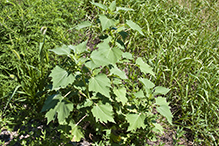 |
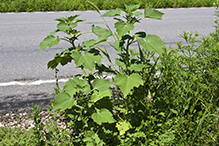 |
||||
Inflorescence |
|||||
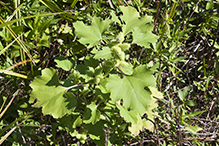 |
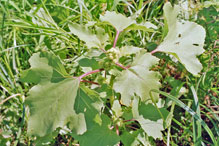 |
||||
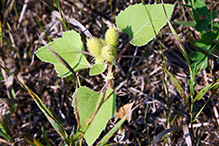 |
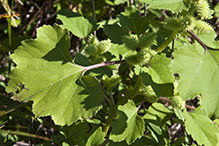 |
||||
Leaves |
|||||
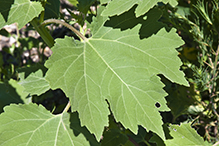 |
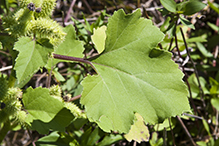 |
||||
Petiole |
|||||
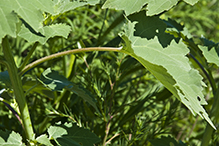 |
|||||
Stem |
|||||
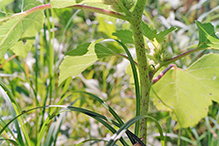 |
|||||
Infructescence |
|||||
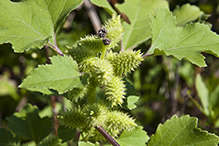 |
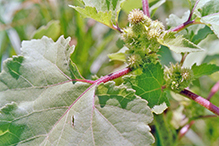 |
||||
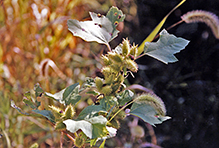 |
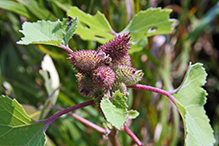 |
||||

Slideshows |
||

Visitor Videos |
|||
Share your video of this plant. |
|||
| This button not working for you? Simply email us at info@MinnesotaSeasons.com. Attach a video, a YouTube link, or a cloud storage link. |
|||
Other Videos |
|||
| Rough Cocklebur (Xanthium Strumarium) - 2012-08-24 W3stlander |
|||
About
Published on Aug 30, 2012 Xanthium strumarium (syn. X. canadense, X. chinense, X. glabratum, Rough Cocklebur, Clotbur, Common Cocklebur, Large Cocklebur, Woolgarie Bur) is a species of annual plants belonging to the Asteraceae family. -------------- |
|||
| Common Cocklebur, Xanthium strumarium, San Diego, California Melvin Wei |
|||
About
Published on Oct 2, 2012 Weedy ground cover plants can be among the toughest plants to identify. I've been looking at this plant all over for three months now before I finally identified it based on its similarity to thornapple, a species of nightshade related to sacred datura, which I have a video of from around the time I first saw this plant. The common cocklebur (Xanthium strumarium) is noted for the prickly seed pods it produces that stick to clothing when one passes by and brushes against the plant. Common cocklebur is highly invasive and has colonized lands all around the world to the point where people are unsure as to where this plant is native to; it is thought that cocklebur is a North American native. The seed pods and the seedlings are highly toxic, containing the toxin carboxyatratyloside; moreover, the entire mature plant contains at least four other toxins. Eating any part of the plant can cause sickness in small quantities, or death in large quantities. In 2007, 19 people died in Bangladesh eating this plant and four times as many people fell ill after a monsoon flood-induced starvation when there was no other vegetation available to eat (probably because everyone else ate the other plants first). Although the foliage looks decent, the thick red stems are perhaps a bad sign. This definitely isn't quite the same looking as the innocuous Yerba Mansa, but it goes to show that if you don't know your plants and mushrooms out there, you definitely do not want to eat whatever just to pass the hunger, especially since leaves and mushroom caps contain so little Caloric energy. Livestock can get poisoned and die from eating this plant. The common cocklebur can grow to over 2 meters tall to form shrubs, and has large leaves for a ground weed with 3 main branched veins in them. As demonstrated amply in the video, bare distrubed soil hiking trails are excellent conduits for bur dispersement, causing entire sections of trail to be flanked on both sides with lush growth of cocklebur. The burs can float and are well suited for dispersement along waterways, but are mainly suited for dispersement by attachment to mammal fur. |
|||
| Environmental Laboratory - U.S. Army Corps of Engineers Environmental Laboratory USACE |
|||
About
Published on Feb 15, 2013 Xanthium strumarium - Common Cocklebur |
|||
| Weed of the Week #801 - Cocklebur (Air Date 8/11/13) AgPhD's channel |
|||
About
Published on Aug 14, 2013 It's our Weed of the Week, Cocklebur. |
|||

Visitor Sightings |
|||||
Report a sighting of this plant. |
|||||
| This button not working for you? Simply email us at info@MinnesotaSeasons.com. Be sure to include a location. |
|||||
| Laurie 9/2/2019 |
Location: La Crescent, Mn Gigantic. 36 plus inches tall. |
||||
MinnesotaSeasons.com Sightings |
|||||

|
Created: Last Updated: © MinnesotaSeasons.com. All rights reserved. |
